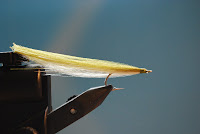
In real life, besides a flyfisherman, I am a veterinarian. That means night and weekend shifts as well, they didn’t tell me that in the first year. J This weekend I was on call again and apparently most animals stayed in healthy condition so I got the opportunity to roam around the neighborhood with a flyrod to see if I can spot some carp. The weather was perfect, although during the daytime it can be a bit difficult chasing them.
Spotting them was as easy today as spooking them, I spotted a good bunch of them all fairly nice sized but they seemed very occupied with things. They were cruising around and none of them were feeding very actively. In the beginning I had trouble distinguishing bream from carp, but after you spot your first carp you’ll know. Carp are way broader then bream en bream have a forked tail and a triangular dorsal fin.
I tried several egg flies as well as pheasant tails and cornballs, alas nothing worked.
Whilst walking back I noticed a big carp lying relaxed on a weed bed , not that jumpy and more importantly not moving so much. I guess laid up carp are better to entice then moving carp, seems that moving carp are pre occupied or something.
I tossed a bad cast but could retrieve it without much disturbance, it may sounds strange but I see this style of fishing as a perfect training when I go tropical saltwater flyfishing. Not that carpfishing is second rate but going abroad has always some pressure ssure of scoring. You don’t want to foul up a cast when there is a huge bone cruising along right? And carp, they’ll be around always.
ssure of scoring. You don’t want to foul up a cast when there is a huge bone cruising along right? And carp, they’ll be around always.
Back to the story, the second cast was perfect, the fly hovered gentle in front of the carp and you could see the big mouth opening and sucking the fly into it. A strip-strike, again a good training, and the fight was on. Fighting this carp I put my material to maximum pressure. There was little room because of the weed beds and lillypads. I nearly locked the reel and heard the rod cracking. I was using 26/100 fluorcarbon. Everything held up and after some minutes I could land the carp in my net. Always bring a net when fishing for carp. With pikefishing I hardly take one, even the big ones can be landed with the gill grip.
She was the biggest for me this far, I guess it was 20 pounds to be on the save side.
I took a few pics and slit her back in the water, what a perfect afternoon.
Spotting them was as easy today as spooking them, I spotted a good bunch of them all fairly nice sized but they seemed very occupied with things. They were cruising around and none of them were feeding very actively. In the beginning I had trouble distinguishing bream from carp, but after you spot your first carp you’ll know. Carp are way broader then bream en bream have a forked tail and a triangular dorsal fin.
I tried several egg flies as well as pheasant tails and cornballs, alas nothing worked.
Whilst walking back I noticed a big carp lying relaxed on a weed bed , not that jumpy and more importantly not moving so much. I guess laid up carp are better to entice then moving carp, seems that moving carp are pre occupied or something.
I tossed a bad cast but could retrieve it without much disturbance, it may sounds strange but I see this style of fishing as a perfect training when I go tropical saltwater flyfishing. Not that carpfishing is second rate but going abroad has always some pressure
 ssure of scoring. You don’t want to foul up a cast when there is a huge bone cruising along right? And carp, they’ll be around always.
ssure of scoring. You don’t want to foul up a cast when there is a huge bone cruising along right? And carp, they’ll be around always.Back to the story, the second cast was perfect, the fly hovered gentle in front of the carp and you could see the big mouth opening and sucking the fly into it. A strip-strike, again a good training, and the fight was on. Fighting this carp I put my material to maximum pressure. There was little room because of the weed beds and lillypads. I nearly locked the reel and heard the rod cracking. I was using 26/100 fluorcarbon. Everything held up and after some minutes I could land the carp in my net. Always bring a net when fishing for carp. With pikefishing I hardly take one, even the big ones can be landed with the gill grip.
She was the biggest for me this far, I guess it was 20 pounds to be on the save side.
I took a few pics and slit her back in the water, what a perfect afternoon.
















%5B1%5D.jpg)
%5B1%5D.jpg)

%5B1%5D.jpg)














